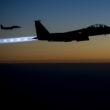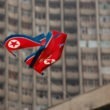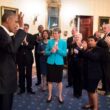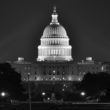Nuclear Posturing
“I’m sure we’ll have several questions here, but principally no new testing, no new warheads … no new missions or capabilities.”
It is Russia that matters, if only because the United States and Russia possess 95 percent of the world’s nuclear weapons. Weapons that are by and large useless. No longer does a U.S. president have to prepare for the split-second decision described two months ago in Newsweek: whether to respond to a Soviet attack by going after the Soviet Union and its Eastern European satellites, or to order up a more limited “urban-industrial” strike that would result in 1,500 warheads detonated over 300 Russian cities. (Upon being briefed on these alternatives, John F. Kennedy is reported to have replied: “And we call ourselves human beings?”)
Russia also matters because Russia and the United States are the principle interlocutors in a conversation that affects the rest of the world. What is remarkable about Obama’s non-proliferation policy is that, while continuing that conversation, he has changed the narrative, recognizing that an urban-industrial strike today would involve terrorists acquiring (or building) and using a nuclear weapon.
If there is no longer a threat of 1,500 or even 100 weapons falling out of the skies, in the words of the pacifist bumper sticker, “One Nuclear Bomb Can Ruin Your Whole Day.” It’s that one bomb that Barack Obama’s non-proliferation policy has set out to intercept.
The release of the stockpile numbers is an important “milestone” in the United States as well, said Steven Aftergood, who directs the Federation of American Scientists’ Project on Government Secrecy.
“To my mind it is one of the single most important declassifications that have ever been taken…,” Aftergood said. “The declassification of the number, numbers I should say, the numbers from 1962 to 2009, those are things for which we never had current numbers before. That information enables a new kind of conversation to take place.”
One thread in that conversation involves renewing the Strategic Arms Reduction Treaty (START) with Russia, which expired in December of 2009. Another will involve a Comprehensive Test Ban Treaty that will follow START. A third involves Obama’s push for an international campaign to secure all fissile material. None of this happened overnight. Obama made non-proliferation part of his campaign. As president, his non-proliferation discussion with the American public—and with the leaders of nations in pursuit of or in possession of nuclear weapons—began in Prague in April 2009, with his pledge that the United States would “seek the peace and security of a world without nuclear weapons.”
Progress since then has been remarkable. On April 8 of this year Obama traveled to Prague to sign a Strategic Arms Limitation Treaty with his Russian counterpart, Dimitri Medvedev. On April 13 and 14, he presided over a nuclear-security summit attended by the heads of 47 nations who came to Washington at his request. On May 3, he announced the declassification of the nuclear warhead count. And on May 4, he announced the release of a completely unclassified Nuclear Posture Review.
Each of these parts of a larger policy set-piece was completed on the eve of the Nuclear Non-Proliferation Conference, which began in the first week in May at the United Nations headquarters in New York and ended May 28. Some observers are describing it as Obama’s “Nuclear Spring.”
I asked Joseph Cirincione how the Obama administration’s Nuclear Posture Review (NPR) measured up to the 2001 Bush-Cheney review. Cirincione worked on defense issues for nine years as a committee staff member on Capitol Hill, before spending eight years as director of the non-proliferation program at the Carnegie Endowment for International Peace. Since 2008, he has been president of the Ploughshares Fund, a nonprofit organization that has worked on peace and security issues since it was founded in 1981.
“Basically,” Cirincione said, “the Obama review begins a transformation of U.S. nuclear policy from one based on massive retaliation against a Soviet nuclear threat to one that deals with the smaller but still deadly threats of the 21st century: nuclear terrorism and new nuclear states.
“If you look at the Nuclear Posture Review from Bush, you’re looking at a document that not only seeks to preserve the existing nuclear doctrine, but seeks to develop new missions for nuclear weapons and develop new more usable nuclear weapons. It is based on a worldview that still saw a need for thousands of these weapons and sought to reduce the barriers to their use.
“The Obama posture says we would be safer with zero nuclear weapons, and we want to reduce the chance that anyone anywhere would use a nuclear weapon,” Cirincione said.
Even for liberals disheartened by the president’s refusal to man up for the public option in the health care bill, his expanded military campaign in Afghanistan, and his choice of Elena Kagan for the Supreme Court, this is change you can believe in.
NEW NUCLEAR POSTURE—”The Bush administration never released an NPR,” said Aftergood. “There was an unclassified foreword of three or four pages and then sections of it that were leaked and [now] appear on the globalsecurity.org site. I don’t think the entire document was ever made public.”
The Obama administration charted a different course. “It’s the first time this has been done on an unclassified basis,” Aftergood said. “According to the Pentagon, it’s not that the NPR was declassified and a public version was released; rather, this is it. This is the Nuclear Posture Review.”
The content of the two documents (at least based on the sections of the 2001 Bush NPR that found their way to sunlight) is as different as the process. The first sentences of the body of each text suggest divergent paths to national security.
George W. Bush’s NPR begins:
Nuclear weapons play a critical role in the defense capabilities of the United States, its allies and friends. They provide credible military options to deter a wide range of threats, including WMD and large-scale conventional military force. These nuclear capabilities possess unique properties that give the United States options to hold at risk classes of targets important to achieve strategic and political objectives.
With the introduction to the Obama administration’s review, you get the sense that we’re not in Texas anymore:
A year ago in Prague, President Obama offered a new direction for coping with 21st century nuclear dangers, declaring that to overcome grave and growing threats of nuclear terrorism and nuclear proliferation, the United States will “seek the peace and security of a world without nuclear weapons.”
Beyond the preambles, the stark differences in nuclear testing policy laid out in the two reports remind us of how far from Texas we have come. The United States has not conducted a nuclear test since 1992, yet the Bush NPR describes a need to “reassess the need to resume nuclear testing and … make recommendations to the President.”
The Obama administration NPR forecloses on testing: “The United Sates will not conduct nuclear testing and will pursue ratification and entry force of the Comprehensive Nuclear Test Ban Treaty.”
Where the Bush posture review provides for new bunker-busting nuclear weapons, the possibility of new nuclear missions, and the development of new warheads, the Obama administration NPR is unequivocal: “The United States will not deploy new nuclear warheads … and will not support new nuclear missions or provide for new nuclear capabilities.”
And while the Obama administration’s new policy of not using nuclear weapons against nations that do not possess or are not pursuing nuclear weapons has provoked a predictable response from right-wing rant radio, it offers a subtle incentive for nations such as Iran and South Korea, and perhaps Syria, to reconsider their weapons programs. (Iran and North Korea are mentioned four times in the report, each time together, linked to the phrase “nuclear ambitions.”)
GOING CRITICAL—Critics of Obama’s non-proliferation policies have turned to the Senate, where the president wants the START to come to the floor for a ratification vote before November. Leading the pack is former U.N. Ambassador John Bolton, who opens with an angry and strident 3,422-word critique in theNational Review. (To be fair, Bolton is angry and strident when he orders “coffee black, no room for cream” from the barista at Starbucks.)
Bolton—the U.N. hater George W. Bush appointed to represent the United States at the U.N.—addresses some of the technical flaws in the treaty. But much of the argument in the National Review is Bolton boilerplate, familiar to anyone who has ever sat through one of his angry stem-winders.
“Approval of American disarmament in European capitals and American academic salons is not proof that disarmament strengthens international non-proliferation norms,” writes Bolton. He warns of an “Obama mindset” that places a higher premium on appeasement than security and has produced a treaty based on “pure theology.”
“Some people are nuclear Neanderthals,” Cirincione said, observing that there is a class of elected officials and technocrats who are undemocratic and dedicated to absolute secrecy, and to a process by which all nuclear weapons issues are decided by a small group working behind closed doors and then sold to the American public.
The Obama administration’s transparency, and Obama’s argument that nuclear weapons should ultimately be eliminated (which we have not heard from an American president since Ronald Reagan worked toward that end with Mikhail Gorbachev), clearly gives the Neanderthals the willies.
The critics are working in a circumscribed space. It’s hard to find any sustained critical movement beyond right-wing publications such as the National Review and the Weekly Standard, and the editorial pages of the Wall Street Journal.
And the critics of Obama’s nuclear policy are increasingly isolated. While you might expect to see a Nobel Peace Prize recipient endorsing fellow Nobel Prizeman Obama, you probably would not expect it to be Henry Kissinger. Kissinger (the most perverse decision the Nobel Committee ever made) has taken the lead in the public campaign supporting START ratification. He has been joined on the op-ed pages of theWall Street Journal by Brent Scowcroft, George Schultz, and James Schlesinger.
When Arizona Republican Senator John Kyl begins in earnest his campaign to stop the treaty (which might not even be a serious campaign), he might find that only John Bolton and Dick Cheney are covering his back.
While this is not your father’s Nuclear Posture Review, it is by no means a pacifist document. On paper and on the ground, missiles remain on alert as part of the mission to hold at risk critical Russian military, political, and economic targets. Bombers remain armed with nuclear weapons. Nuclear labs continue their research. There is also $80 billion over 10 years for modernization of operational weapons and more money for the research labs, and START reductions are modest.
But we are witnessing a definite departure from the past.
“The other secret about this,” said Cirincione, “is that the military cares less and less about nuclear weapons. What drove the Bushies was ideology, not military requirements. This is much more in line with what the military thinks they need.
“The president has not just laid out a transformative posture but one that brings the military leaders along with him,” said Cirincione. “One of the big achievements of this posture is that he now has the secretary of defense and all the military leaders with him—and the secretary of defense and the joint chiefs of staff solidly on board for the ratification of the Test Ban Treaty. This is a posture review that laid down a future for U.S. nuclear weapons in which there is no testing, no nuclear weapons, and no new missions.”
A future unlike that imagined by Secretary of Defense Donald Rumsfeld when he wrote the introduction to the still-classified Bush Administration Nuclear Posture Review in 2001.
| Status of World Nuclear Forces 2010 | ||||
|---|---|---|---|---|
| Country | Strategic | Non-Strategic | Total Operational | Total Inventory |
| Russia | 2,600 | 2,050 | 4,650 | 12,000 |
| United States | 1,968 | 500 | 2,468 | 9,600 |
| France | 300 | n.a. | 300 | 300 |
| China | 180 | ? | 180 | 240 |
| United Kingdom | 160 | n.a. | <160 | 185 |
| Israel | 80 | n.a. | n.a. | 80 |
| Pakistan | 70-90 | n.a. | n.a. | 70-90 |
| India | 60-80 | n.a. | n.a. | 60-80 |
| North Korea | <10 | n.a. | n.a. | <104 |
| TOTALS | 5,600 | 2,550 | 7,900 | 22,500 |
|
Table:https://www.ploughshares.org/news-analysis/world-nuclear-stockpile-report |
Nuclear Statehood
Nine nations now belong to what was once a much smaller “nuclear club.” With a total inventory of 12,000 nuclear warheads, Russia maintains the world’s largest arsenal, according to the Federation of American Scientists’ Kristensen. Senate committee hearings on START—the treaty by which the Obama administration hopes to use U.S. and Russian weapons reductions to encourage the other seven nuclear armed nations to begin reductions—began in mid-May.






0 Comments